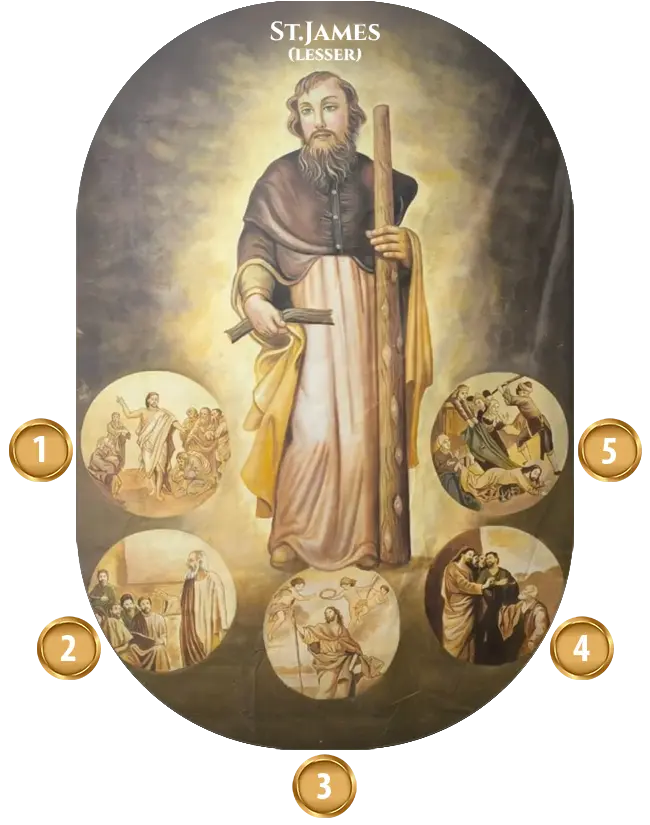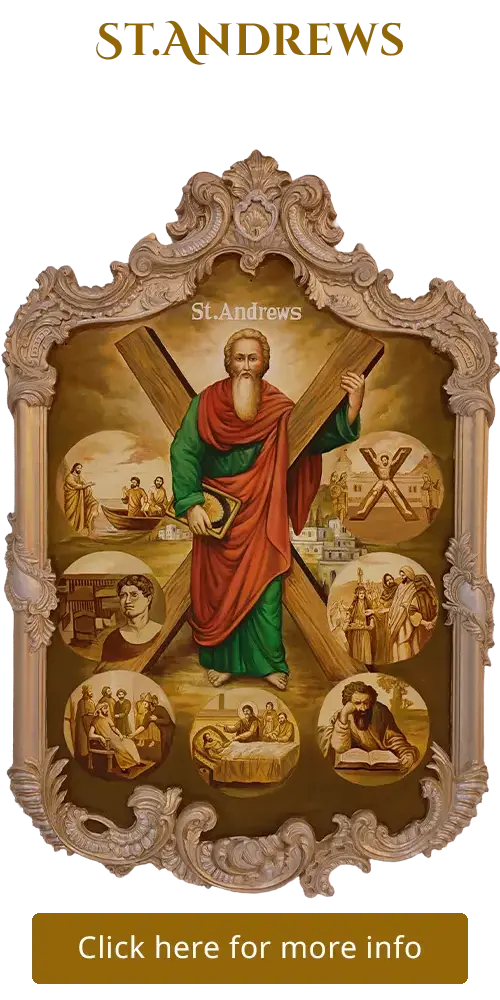St. James les
Inside Paintings - North Wall
St. James (Lesser)



1. Call to Discipleship
Biblical Reference: Matthew 10:2-4, Mark 3:16-19, Luke 6:14-16
Description: St. James the Lesser, also known as James, son of Alphaeus, was one of the Twelve Apostles chosen by Jesus Christ. The New Testament lists him among the apostles, but does not provide specific details about his call to discipleship. Likely from Galilee, James was called by Jesus to “Follow me,” as with the other apostles, prompting him to leave his former life to join Christ’s mission. His immediate response to Jesus’ invitation reflects his faith and commitment to spreading the Gospel, a role he fulfilled as a witness to Jesus’ ministry, death, and resurrection, later becoming a key figure in the early Church.
2. Witness to Jesus' Resurrection
Historical Reference: Christian writings & traditions
Description: St. James the Lesser was one of the Twelve Apostles and, as such, a witness to Jesus Christ’s resurrection.
While the New Testament does not explicitly single out James the Lesser in resurrection accounts, his inclusion among the apostles (Matthew 10:3, Mark 3:18, Luke 6:15, Acts 1:13) implies he was among the disciples who encountered the risen Christ.
According to Acts 1:3-4, Jesus appeared to the apostles over forty days after His resurrection, teaching them about the Kingdom of God, and James, as part of this group, was present for these events. His role as a witness to the resurrection equipped him to testify to Christ’s victory over death, strengthening his apostolic mission in the early Church, particularly in Jerusalem, where tradition holds he later served as a leader.
3. Leadership in the Early Church
Historical Reference: Christian writings & traditions
Description: St. James the Less, the author of the first Catholic Epistle, was the son of Alphaeus of Cleophas. His mother Mary was either a sister or a close relative of the Blessed Virgin, and for that reason, according to Jewish custom, he was sometimes called the brother of the Lord. James of Alphaeus is named in each listing of the 12 disciples, always appearing ninth in the order. The Apostle held a distinguished position in the early Christian community of Jerusalem. St. Paul tells us he was a witness of the Resurrection of Christ; he is also a “pillar” of the Church, whom St. Paul consulted about the Gospel.
As an apostle, James the Lesser was a foundational figure in the early Christian community, present at key events like the selection of Matthias (Acts 1:13) and the outpouring of the Holy Spirit at Pentecost (Acts 2:1-4). he was the first Bishop of Jerusalem and played a prominent leadership role in Jerusalem, presiding over the Council of Jerusalem (Acts 15), where he helped decide that Gentile converts were not required to follow Mosaic law, a pivotal moment for the Church’s expansion. His leadership was marked by wisdom, mediation, and fidelity to the Gospel, earning him respect among Jewish Christians.
He guided the Jerusalem Church through tensions between Jewish and Gentile Christians until his martyrdom.
4. St. James the Lesser’s Faith and Ascetic Life
Historical Reference: Christian writings & traditions
Description: St. James the Lesser, one of Jesus’ twelve apostles and often identified as the son of Alphaeus, is renowned for his deep faith in God and his disciplined lifestyle. Known for his humility and devotion, James abstained from wine and meat, embracing a life of simplicity and prayer that reflected his spiritual commitment. Early Church tradition, including writings from Hegesippus, describes him as a man of such piety that he spent long hours on his knees in the Jerusalem Temple, his devotion earning him the nickname “James the Just.” His faith shone through his leadership of the Jerusalem church and his authorship of the Epistle of James, which emphasizes practical faith and righteousness (James 2:17).
This ascetic life, marked by his avoidance of worldly pleasures, underscored his trust in God’s provision.
5. Martyrdom of St. Jude
Historical Reference: Christian writings & traditions
Description: St. James the Lesser, also known as James, son of Alphaeus, met a martyr’s death for his faith. According to early Christian traditions, notably recorded by Hegesippus and referenced in Eusebius’ Church History (Book II, Chapter 23), James was martyred in Jerusalem around 62 AD.
As a leader in the Jerusalem Church, he was known for his piety and devotion to Christ. Jewish authorities, angered by his preaching of Jesus as the Messiah, seized him during a period of unrest. They brought him to the pinnacle of the temple and demanded he renounce his faith. Instead, James boldly proclaimed Christ’s divinity, leading his accusers to throw him down from the temple. Though injured, he survived the fall and continued praying, but was then stoned and ultimately killed by a blow to the head with a club or fuller’s staff. His martyrdom, celebrated on May 3 in the Western Church, solidified his legacy as a steadfast witness to the Gospel.







